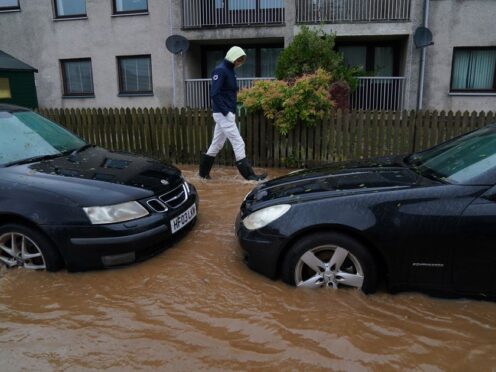
Meeting net zero commitments could cost the Scottish Government an average of more than £1.1 billion a year until 2050, a report has warned – with experts saying ministers may have to therefore cut spending in other areas or raise taxes.
The Scottish Fiscal Commission (SFC) also said meeting the Government’s interim target of reducing emissions by 75% by 2030 could be a “fiscal risk”.
The 2030 target “could be difficult to manage within the Scottish budget”, it said, as its report warned: “We think it could be difficult for Scottish Government to fund meeting it.”
It said more than £35.2 billion additional capital investment could be required in Scotland over the period 2020 and 2050 – the year the UK is due to meet its net zero target.
The Climate Change Committee have described the Scottish Parliament’s 2030 emissions reduction target as “extremely challenging.” We think it could be difficult for Scottish Government to fund meeting it. https://t.co/ceGD2z2BXr pic.twitter.com/rbFmgxNfqS
— Scottish Fiscal Commission (@scotfisccomm) March 14, 2024
The SFC said under its assumptions, “the average additional capital investment required per year by the Scottish Government is £1,136 million”.
That amounts to the equivalent of £207 per person, per year – higher than the £149 per person, per year the SFC said will be needed across the rest of the UK.
This difference is because while Scotland has about a third (32%) of the UK land mass, it has roughly half of its trees and 70% of its peatland, with the SFC pointing out this means the Scottish Government will need to invest more in the key area of land use, land use change and forestry.
As a result of the cash needed – with £1.1 billion representing just under a fifth (18%) of the Scottish Government’s capital budget – and the higher amount of spending required per person, the SFC said: “This will create a pressure for the Scottish Government to manage as it will have to meet the differential need from within its existing budget or raise more revenue from other devolved sources.
“The scale of investment required to meet its targets is expected to create a fiscal pressure for the Scottish Government.
We’ve just published our first Fiscal Sustainability Perspectives paper on the topic of how climate change could affect the Scottish Government’s fiscal sustainability. Find out more: https://t.co/ceGD2z2BXr pic.twitter.com/WREtMcUTri
— Scottish Fiscal Commission (@scotfisccomm) March 14, 2024
“To address this fiscal pressure, the Government would have to decide whether to cut spending in different areas, use non-spending levers to achieve its objectives, or raise additional revenue.”
But while the report concluded meeting the 2030 target “presents a substantial pressure for public spending”, it said Scotland’s target for achieving net zero by 2045, five years ahead of the UK, is “not considered a risk in the same way”.
SFC chairman Professor Graeme Roy said for Scotland to meet its net zero targets, investment will be needed in “everything from decarbonising public sector buildings, investments in public transport and flood defences and the like”.
He added: “With devolution, a lot of these responsibilities are going to land on the Scottish Government.”
Our chair, @ProfGraemeRoy, explains the findings of our recently published Fiscal Sustainability Perspectives: Climate Change paper. https://t.co/ceGD2z2BXr pic.twitter.com/WgJuR6LsDO
— Scottish Fiscal Commission (@scotfisccomm) March 14, 2024
But while the report looked at the costs of meeting net zero commitments, Prof Roy insisted: “Doing nothing, not responding to the challenge of climate change, will be far more expensive and damaging to the public finances than investing in net zero.
“Unmitigated climate change would be disastrous for the public finances. Economy, society and crucially our public finances. It is simply not an option.”
Campaigners at Oxfam Scotland argue the onus should be on the “biggest polluters” to pay towards dealing with climate change.
Advocacy adviser Lewis Ryder-Jones said: “There’s no denying the transition to net zero will be expensive, but delaying investing in climate action is like putting off fixing a leaky roof until the entire house is flooded. The longer governments procrastinate, the bigger the bill becomes.
“It’s a no-brainer that the biggest polluters, who are raking in record profits and amassing huge fortunes, must pay for the climate damage they disproportionately fuel and the cost of building a fairer low carbon future.”

Net Zero Secretary Mairi McAllan stressed reaching net zero is an “environmental imperative and our moral obligation”.
She added: “Done correctly, achieving net zero is also a significant economic opportunity for Scotland.
“In 2024-25 alone, we are committing £4.7 billion in capital and resource for activities that will have a positively impact on delivery of our climate change goals.
“However, delivering the infrastructure required to meet net zero will also require responsible investment by the private sector and, crucially, the UK Government, who needs to stop shirking their responsibility and invest.
“That’s why it is deeply concerning that we are expecting a real-terms cut to our UK capital funding of 8.7% over five years, totalling around £1.3 billion.”
Ms McAllan urged the UK Government to “change course” and “ensure future financial settlements provide us with the resources we need to secure a just and fair transition to net zero”.

Enjoy the convenience of having The Sunday Post delivered as a digital ePaper straight to your smartphone, tablet or computer.
Subscribe for only £5.49 a month and enjoy all the benefits of the printed paper as a digital replica.
Subscribe